PaTRAM Co-founder Maestro Gorbik conducts the National Symphony Orchestra of Uzbekistan
News from Uzbekistan, Classical music of the highest quality: Immortal musical works performed in Tashkent.
Written by: Inessa Gulsarova
“Music should strike fire from the heart of man, and bring tears from the eyes of woman.” – These words belong to the great German composer, Ludwig van Beethoven, and it serves as an epigraph to a concert of classical music, which was recently held at the State Conservatory of Uzbekistan. This thought wonderfully conveys the atmosphere that prevailed that evening in the Great Hall of the famous Uzbek University, under whose arches the immortal music of Beethoven, Bizet and Tchaikovsky, resounded. Each of these great composers put their hearts, their thoughts, and their attitudes towards life into these magnificent works. And these attributes were reflected by those self-same qualities of the artists who performed that evening on the concert stage. It may seem from the photos that the empty seats at the beginning of the concert meant that the audience was not expecting anything special. However, happily, the concert hall was later filled to capacity, and more, the audience was treated to an exceptional holiday concert for music lovers.
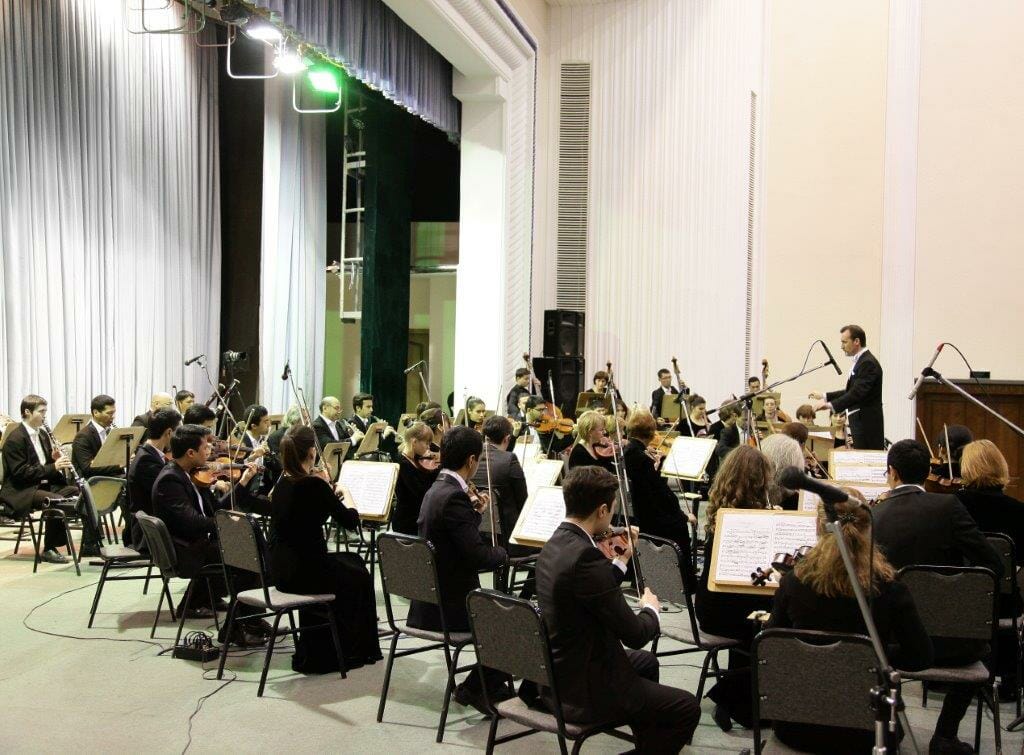
The program included Beethoven’s Second Symphony and his Egmont Overture; Habanera, from Bizet’s opera Carmen, featuring the award-winning soloist Aziza Mukhamedova; and Variations on a Rococo Theme by Peter Ilyich Tchaikovsky, featuring Sardor Ibragimov, also an award-winning soloist. However, as the saying goes, let’s look at everything decently and in order. On the stage we saw the Honored Collective of the National Symphony Orchestra of Uzbekistan, directed by Alibek Kabdurahmanov (on the photo he is on the right).
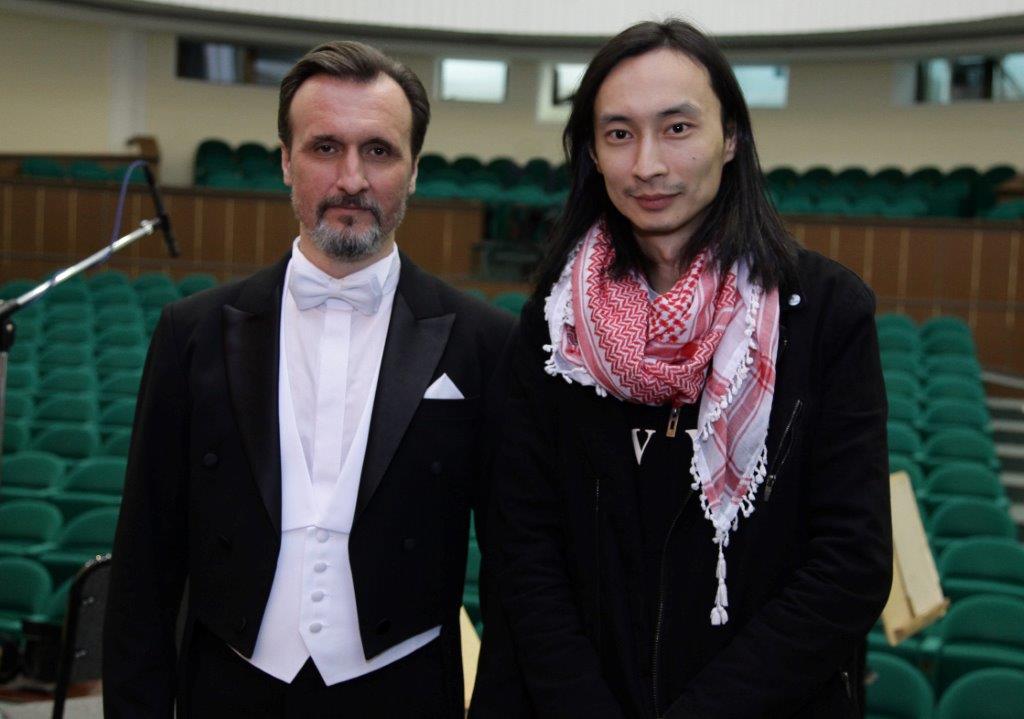
People’s Artist of the Republic Ismail Dzhalilov is the artistic director of the orchestra. At the conductor’s stand we also saw our guest from Russia, the multiple award-winning Maestro Vladimir Gorbik, whom the Tashkent audience first met at the International Festival of Arts, themed “Golden Autumn”, last year. The program started with a performance of Beethoven’s Second Symphony (Opus 36), which was interpreted in an unusually fresh and joyful manner. Many times when this piece is performed it is done in a heavy-handed manner, and a listener feels “clobbered” by such an interpretation of this work. Not so under Maestro Gorbik’s direction!
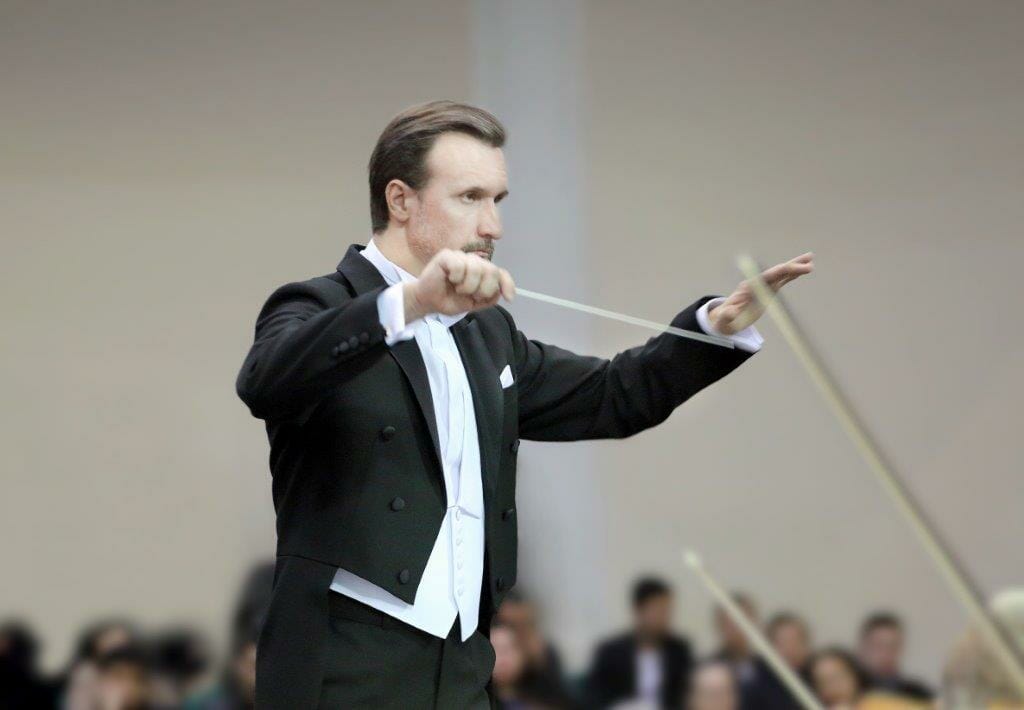
Written in 1802 by Beethoven when he was thirty years of age, this symphony is the most perfect work of this young author. During that time, Beethoven had already begun to suffer from the first strong attacks of deafness. Following the advice of his doctors, he spent the summer of 1802 alone in a cozy rustic cabin in Heiligenstadt. The composer was happy to experience a temporary improvement in his hearing. The cheerfulness of a young man woke up in him, his heart once again full of endless fun and love for life. This is precisely the content of his Second Symphony – sunlight and joyfulness. Structurally, this symphony is much like Beethoven’s first one, in that it continues in the traditions of Haydn and Mozart. However, the Second Symphony contains some innovative features: the clearly expressed feeling of heroics and monumentality; and in this work, the Minuet, a part of the symphony that is like a dance, has disappeared and is replaced by the Scherzo.
In his own interpretation of Beethoven’s works, Maestro Gorbik emphasized the monumentality of the composer’s intent, his heroic pathos and dramatic contrasts, building the symphonic opus from bravely persevering energy in the first movement, through a profound Larghetto and Scherzo that is full of humor, to a vivid, life-affirming finale.
The orchestra demonstrated its level of excellence, presenting the works deeply and with emotion. Following the Second Symphony, the orchestra launched into the Egmont Overture (Opus 84), one of Beethoven’s most famous works. Written in 1810, and inspired by the tragedy of Goethe, this composition demonstrates not only the strength and brightness of musical imagery, but also its utmost clarity, leaving the audience no room for doubt. This composition was written during the period of Beethoven’s greatest creative energies. The central idea of the Egmont Overture’s whole musical-dramatic composition is clearly and simply expressed: the struggle for freedom and the joy of achieving it. In Maestro Gorbik’s interpretation, the orchestra captured all the musical detail, and presented Beethoven’s opus in its highest form, clearly showing the composer’s own apotheosis and triumph.
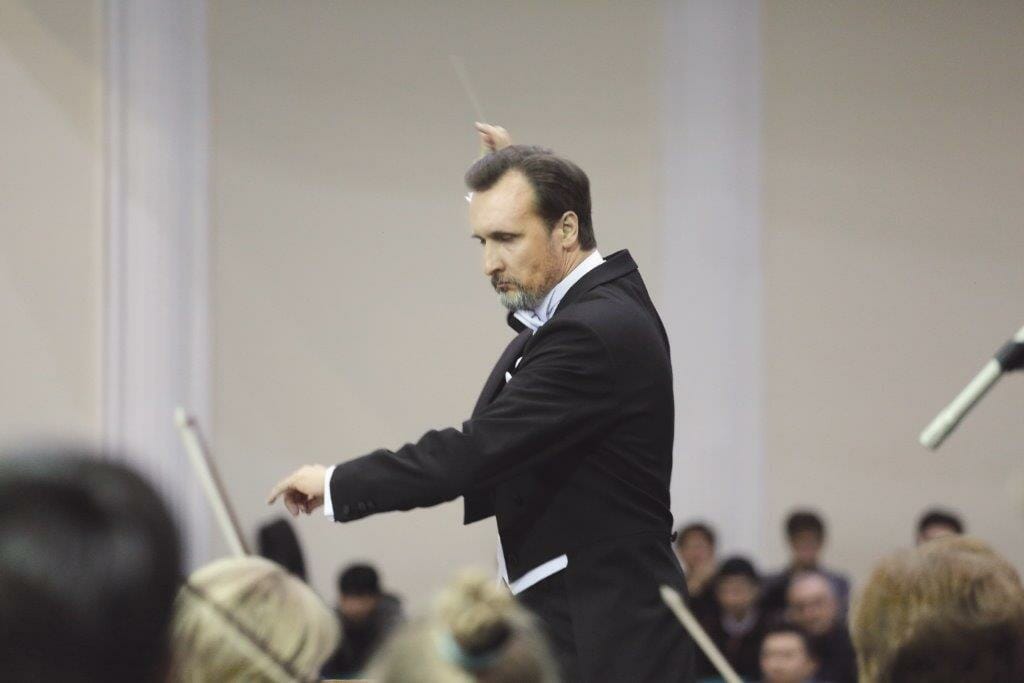
The popular piece Habanera, from the opera Carmen by Bizet, came next. This was performed by one of the soloists from the Alisher Navoi Theatre, the diplomat Aziza Mukhamedova, who in a small solo piece was able to masterfully reveal through a gesture, a look, a smile, or a movement, the fiery temperament and the nature of Carmen – the strong-willed, proud and passionate heroine. While listening to Aziza’s performance of Habanera, the hall was plunged into a world of vocal fantasy, as Mukhamedova brought the audience to experience Carmen’s own delight from the unexpected results of her own capricious and passion-filled actions.
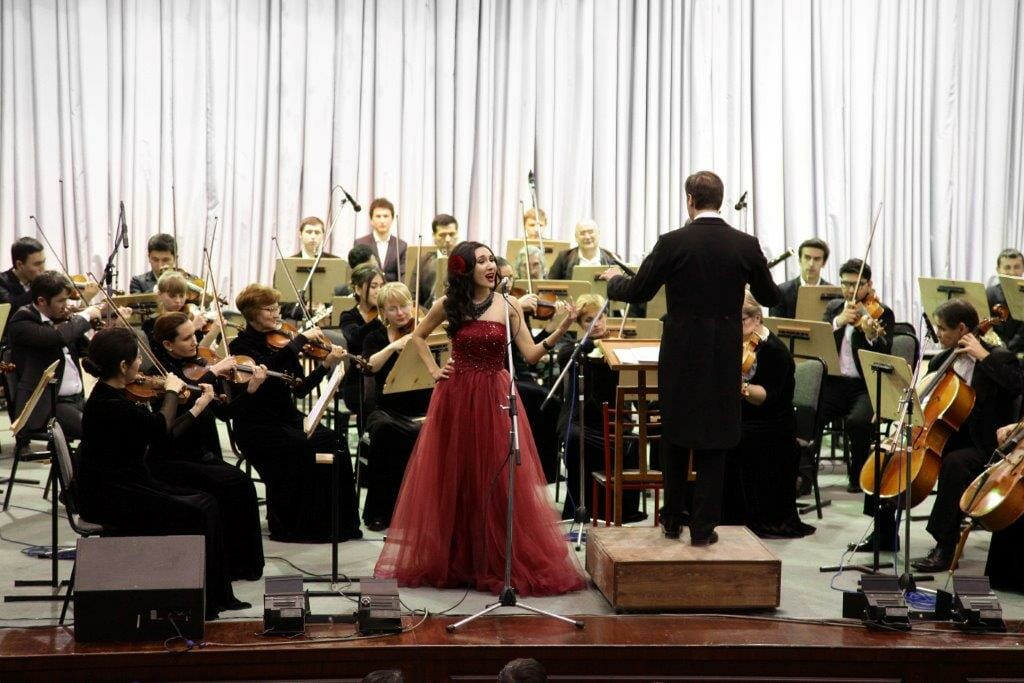
This full-sounding mezzo-soprano impressed the audience with the depth and richness of her voice. The orchestra was a most worthy partner of the soloist and this is of considerable credit to the conductor, who had obtained a truly emotional response from the orchestra. I would like to especially note Maestro Gorbik’s attention to details and his ability to present them.
Tchaikovsky’s Variations on a Rococo Theme for Cello and Orchestra (Opus 33), known today as one of the most popular models of cello concert literature, was the next piece we heard. Given the superb nature of this piece, it seems strange that during Tchaikovsky’s own lifetime this work was only rarely performed.
Tchaikovsky worked from 1876 to 1877 on the Variations. In the author’s original notation, the work consists of an introduction, the theme and eight variations. In the foundation of the Rococo theme we can hear the melody of the Russian folk song “Along Peterskaya Street.”
This Tchaikovsky opus is very challenging for any soloist. The difficulty lies in the fact that the twenty-minute variations are played without orchestral tutti, which would give the cellist an opportunity to rest a little. However, the nobility of expression, simplicity and elegance, along with a strong virtuoso beginning, provides to the soloist incredible opportunities to showcase his or her own talent.
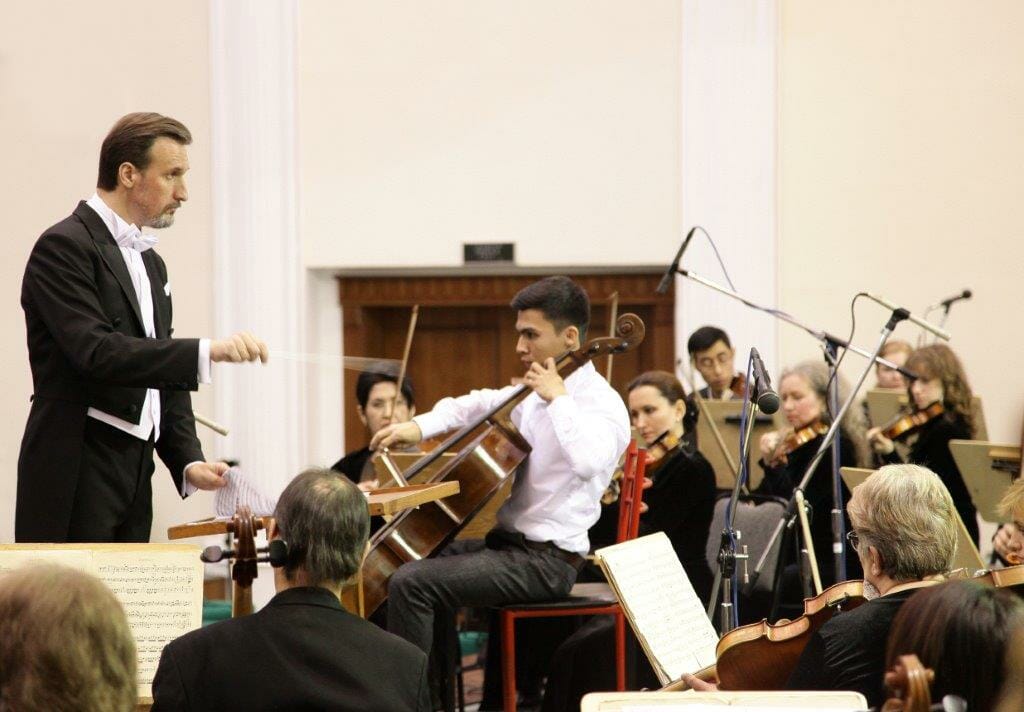
Sardor Ibragimov, an award-winning student of the Honored Artist of Uzbekistan, Anvar Raimdzhanov, was superbly prepared as the solo cellist. Deftly, with his usual ease, he showed his mastery of the technical difficulties of the score. From his very first notes, he captivated the audience. It felt as if Ibragimov was playing personally for each person in the audience, holding them with every nuance, and keeping his listeners in breathless suspense until the very last note. His ability to play with all the nuance, all the dynamic contrasts and shades – from the finest pianissimo to a powerful forte – mesmerized all in his audience. It was glorious to listen to, and Sardor was beautifully and perfectly supported by the sensitive accompaniment of the orchestra, itself attentive to the exact gestures of Maestro Vladimir Gorbik, who listened with greatly focused attention to the soulful playing of the soloist.
Translated by: Seraphim Hanisch
